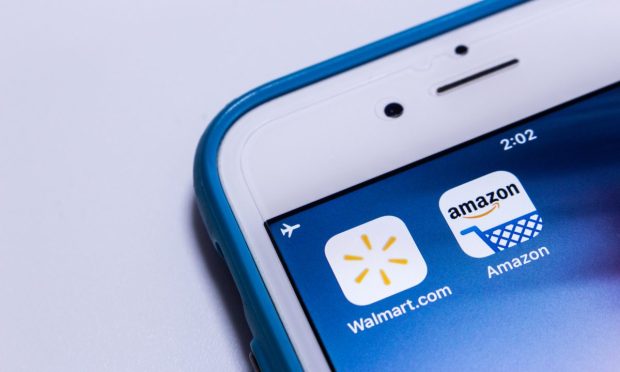Amazon, Walmart Incentivize eGrocery Spending with Deal Days

As mega-retailers compete for consumers’ food spending, Amazon is pulling out all stops to minimize Walmart’s grocery lead. During its Prime Day event Tuesday and Wednesday (July 12-13), Amazon touted grocery savings for Prime members, and the retailer had a range of deals and discounts on food and beverage products.
Read more: Amazon, Target Leverage Deal Days to Drive Grocery Sales
Research from PYMNTS’ recent study “The Ongoing Battle for Consumer Retail Spend: Amazon Versus Walmart Q1 2022: The Grocery Wild Card,” noted that, while Amazon holds a 53% share of all eCommerce spending in the U.S., Walmart’s share of the food and beverage market, as of Q1, exceeded Amazon’s nine-to-one.
Specifically, the study, which drew from the companies’ quarterly earnings reports as well as proprietary field data, found that Walmart held a 17.7% share of all food and beverage (F&B) sales in the quarter, while Amazon held only a 1.9% share. That being said, Amazon’s F&B market share has held relatively constant in the past couple of years, while in Q1, Walmart’s slipped nearly 2%.
Read the full report: The Ongoing Battle for Consumer Retail Spend: Amazon Versus Walmart Q1 2022: The Grocery Wild Card
Additionally, research from PYMNTS’ recent study, “Walmart+ Weekend: Prime Rival or Trip to the Grocery Store?,” found that more than twice as many of Walmart’s Deals for Days participants make grocery purchases as Amazon’s shoppers. Specifically, the report, which drew from a June survey of nearly 2,900 consumers, including 2,055 Amazon Prime subscribers and 1,047 Walmart+ subscribers, of which 668 respondents participated in Walmart+ Weekend in June, noted that 57% of Walmart+ Weekend 2022 shoppers and 24% of Prime Day 2021 shoppers doing so.
Get the study: Walmart+ Weekend: Prime Rival Or Trip To The Grocery Store?
Amazon’s F&B efforts are helped this year by an influx of new Prime Day participants. Amazon has called this year’s event “the biggest Prime Day event in Amazon’s history,” with record sales. In fact, U.S. Prime members bought over 60,000 items per minute, per the company news release.
See more: Amazon Delivers Biggest Prime Day Event Ever
Amid this rush, the eGrocery market opportunity is significant. Research from the July edition of PYMNTS’ ConnectedEconomy study, “The ConnectedEconomy™ Monthly Report: The Rise of the Smart Home,” which drew from a May survey of roughly 2,700 U.S. adults, found that 17% of consumers buy restaurant food or groceries online each day.
Read more: New Data Shows Convenience Drove Smart Home Upgrades for 83M Consumers in 2022
Amazon is also seeking to boost grocery sales outside of just its eCommerce channels. The company is stepping up its in-store offerings including rolling out “Just Walk Out” frictionless checkout to many of its stores and boosting other self-service options as well. Most recently, the company announced Monday (July 11) an update to its Dash Cart smart shopping carts at Amazon Fresh and Whole Foods Market stores that includes doubling the carts’ capacity and allowing for parking lot unloading.
See also: Amazon Updates Dash Carts as Self-Service Gets a Facelift